#Spiritual Encounter with Dolores
Explore tagged Tumblr posts
Text
My Spiritual Encounter with Dolores Cannon – Master of QHHT

The journey of expanding consciousness is a lifelong pursuit, filled with moments of revelation, healing, and growth. My encounter with Dolores Cannon and my dedication to QHHT have opened doors to realms of understanding I never imagined. As I continue on this path, I invite you to explore the transformative power of QHHT, and to embark on your own journey of healing and self-discovery. Together, let us honor the legacy of Dolores Cannon and carry forward her teachings, as we strive to expand our consciousness and embrace our true purpose.
#spiritual coaching#personalized meditation tips#the tranquillity meditation classes#Quantum Healing Hypnosis Technique#power of QHHT#Spiritual Encounter with Dolores#The Path to QHHT#Dolores Cannon#practice QHHT#QHHT-style Temple of Healing#Regression Therapy#Master of QHHT
0 notes
Text
“The word ‘chivalry’ comes from the French ‘chevalier’, which means ‘knight’ or ‘horseman’. Symbolically, the horse represents the body and its associated energies and emotions, while the rider represents the higher self of the human being, the best and noblest part of ourselves. The knight is not perfect, but is on a path towards perfection. Hence the trials that all knights go through. They sometimes fail, especially in the phase of the Quest of the Holy Grail, and sometimes they get another opportunity and then partially or wholly succeed. In the view of esoteric philosophy, the human being is perfectible; indeed, our destiny as human beings is to develop the divine part of ourselves. All this was symbolized in the esoteric art par excellence, namely alchemy: the transmutation of the man of lead (earthly, heavy and opaque) into the man of gold (shining, incorruptible, pure and endlessly giving like the sun). It is therefore not surprising that we will find many traces of alchemy in the tales of chivalry. As J.E. Cirlot says, “Knighthood should be seen, then, as a superior kind of pedagogy helping to bring about the transmutation of natural man (steedless) into spiritual man.”
The hallmark of chivalry is nobility – not of blood, but of character. And what is nobility of character but the mastery of one’s lower traits by the higher, not giving in to base impulses, always striving for the good? In this sense, it is not only a product of the European Middle Ages, but a universal ethical vision. However, chivalry is best known as a medieval phenomenon, with a historical aspect and mythological aspect.
Historically, the ideal of chivalry arose after the fall of the Roman Empire, in response to the increasing barbarism of the Dark Ages. This was the setting for the legend of King Arthur and his Knights of the Round Table, which is widely accepted as having some basis in historical fact. As Ramon Llull writes in his classic Book of the Order of Chivalry, “There was once no charity, loyalty, justice or truth in the world. Enmity, disloyalty, injustice and falsehood came into being… [and when this happened] justice sought to recover its honour.” Thus, chivalry comes to restore justice, harmony and truth in an unjust and brutal world. The peak moment of the popular revival of chivalry, however, came around the twelfth century. Most scholars agree that it was inspired by the Islamic world, at that time a flourishing civilisation, which the medieval Europeans encountered through the Crusades.
From around this time came a massive revival and popularisation of the “Arthurian cycle” of stories, based on older sources but now put into literary form. The typical knight goes through trials and difficulties, often in the context of magical adventures, where he has to overcome impossible odds.
One example of this is the story of Sir Lancelot and the Dolorous Garde. This is the name of a castle which is under a curse. Many knights have attempted to lift the curse but none has succeeded. The test consists in having to fight his way through three gates, each of which is defended by ten knights. Lancelot (in this tale known as the White Knight) only succeeds because he has the help of a damsel who has been sent to his aid by the Lady of the Lake. She gives him three shields which will double, triple and quadruple his strength when it is failing.
Usually, in these stories, and in mythology in general, the damsel represents some higher element of the soul, a spiritual element which can help us in our hour of need. It is represented as a damsel, or virgin, to symbolise the purity of the spiritual element.
Then a strange and mysterious figure appears: Brandin, the “Copper Knight”, the ruler of the Dolorous Garde. He appears on a wall, disturbed by Lancelot’s success and, leaning over too far, falls on top of one of his own knights, killing him. Why copper? Each of the metals has a part to play in the alchemical process and is associated with one of the planets, in this case Venus. The symbolism of alchemy is highly complex and I will not attempt to decipher it here, but this “Copper Knight” is too incongruous to be anything but alchemical.
Finally, Lancelot triumphs and is led to a cemetery where the failed knights are buried. There he is shown a metal slab (metal again!). On lifting it he finds out the name of his true father, i.e. his real identity. In other words, the end of all these trials is to discover who we truly are – a question which I think many of us would love to be able to answer.
There are many such strange stories in the Arthurian legends. In the story of Parzival, by Wolfram von Eschenbach, at one point the hero finds himself in a room in a castle, when suddenly the floor begins to rotate. It gets faster and faster until he has to cling on for dear life in order to avoid being dashed against the wall. In some accounts of the trials to which candidates for Initiation were subjected, the trial of the rotating floor is not uncommon. In another Lancelot story, he has to cross a “sword-bridge” over an abyss, at the end of which two lions are waiting to devour him. His love for Guinevere (the spiritual soul?) gives him the courage to cross this painful bridge. But when he arrives at the other side, fully expecting to have to fight the lions, he finds that they have vanished; they were only magical illusions needed to try his courage. How many of our fears are illusions, created by our own minds?
There are also many intriguing images associated with chivalry. The one shown opposite, from the Manasseh Codex, shows a female figure with an arrow and a flaming torch above the head of
the mounted knight. The figure almost certainly represents Venus (sometimes shown in alchemical texts with the “arrow of the secret fire”), the inspiration for the courage of the knight. Below his horse is a kind of watery (inner/astral?) world in which two demon-like figures – or one demon and one man – are battling each other, the demon pointing the arrow and the man, or other demon, defending himself with his shield. This illustrates the fact that chivalry was not only about external battles and adventures, but also, and perhaps most importantly, about the inner battle between the higher and lower selves of the human being.
Ramon Llull states that the virtues of the knight (his inner conquests) are more important than his physical prowess: “Therefore the knight who practises these things that pertain to the Order of Chivalry with respect to the body but does not practise those virtues that pertain to Chivalry with respect to the soul is not a friend of the Order of Chivalry.”
There is also a rich symbolism of colours, again associated with alchemy. In Mallory’s Morte d’Arthur, Sir Tristram fights in a tournament and on different days and times arrives dressed in different colours, particularly green, black and red (generally in that order). Several authors believe that this is not just “for atmosphere”, but is related to the stages of the alchemical work. These could be: green – the universal solvent, as in the Green Lion; black – the nigredo phase associated with “germination in darkness”, and red – the rubedo phase, associated with the final stage of the work, or “exaltation”.
And what is the goal of alchemy? The Philosopher’s Stone, which symbolises the achievement of all powers, the mastery over oneself and nature; the power to heal, to make whole and even to prolong life. It is interesting, then, to note that in Wolfram von Eschenbach’s Parzifal, the Holy Grail is described not as a chalice but as a stone. The Grail, like a cauldron of plenty, has the power to nourish endlessly and, if the right questions are asked, to heal the King (the Self) and the Kingdom (the World).
Thus, to have a vision of the Holy Grail is equivalent to achieving the Philosopher’s Stone. And to get to that goal, the knight must become absolutely pure, like Sir Galahad. In the view of the esoteric philosophy, this is not impossible. It is the fruit of a long labour of purification, symbolised by the trials and adventures of the knight.”
The Esoteric Aspect of Chivalry By Julian Scott
#Chivalry#The Quest of the Holy Grail#Esoteric Philosophy#Soul Alchemy#Soulmaking#Soulcraft#The Man of Gold#Knighthood#Spiritual Man#Nobility#Endlessly giving like the sun#The legend of King Arthur and his Knights of the Round Table#The Arthurian legends
4 notes
·
View notes
Text
Jungkook first life.
I've really been thinking about the phrase "Jungkook first life" It's just a fun idea I've been thinking about, and I hope it doesn't offend anyone. This is a little insight from someone who loves exploring spirituality, the wonders of the universe, the idea of fate, past lives, and the soul.
-First point: This is his inaugural life on Earth. Delving into Dolores Cannon's insightful books, one encounters a fascinating term that discusses the waves of souls volunteering to incarnate here. These souls originate from other realms and choose to come to Earth with a noble purpose: to elevate the frequency of our planet. In essence, they embody joy and positivity, radiating this vibrant energy throughout the world.
While I'm uncertain if he truly belongs to this cosmic wave, there's no doubt that his presence brings a remarkable positive influence. His energy is palpable; just witnessing his infectious smile can instantly lift one's spirits. He emanates a cleansing energy, as my friend, the fortune teller, astutely pointed out.
These extraterrestrial souls have never known life on Earth, which leads them on a unique journey filled with lessons. Even when they become fully human, they often grapple with certain challenges. They may struggle to grasp the complexities of this world, experience a longing to return to their origins, or exhibit behaviors that seem peculiar to those around them. Nonetheless, their pure essence shines through, contributing to the richness of the human experience.
-The second point to consider is the belief that he has not experienced life solely for the first time. I propose a theory that suggests he has undergone multiple incarnations or may possess an extraterrestrial essence that is engaged in karmic experiences while residing in a human form. This notion is supported by his remarkable ability to quickly observe and assimilate knowledge, as well as his proficiency in various seemingly disparate domains, including physical fitness, creativity, the arts, and culinary skills. It is evident that, through the myriad lessons acquired across different lifetimes, his soul has amassed a wealth of experience. Consequently, in this current existence, he appears to be oriented towards positive pursuits.
I want to clarify that this post presents my theory on "Jungkook's first life." I’m sharing it because the energy BTS, especially Jungkook, brings is incredibly uplifting and significantly enhances my mood. Finding someone as genuinely pure as he is a rare treasure, and that is truly invaluable.

2 notes
·
View notes
Text
Lolita - Vladimir Nabokov (Book Review)

What no one tells you about reading Lolita is that there is an initial visceral shock to encountering a very fucked up story. And then years later, you read it again in full attention and skill without realizing that so much tears have run out of you.
Me at 15: “this is horrific.”
Me at 22: “sad, sad, sad.”

I found myself weeping the moment I woke up from a nap induced by the memory of Nabokov’s novel. Lolita is told from the perspective of the pedophile himself, Humbert Humbert. What I respect so much from Nabokov is that no matter how, in minute subtle ways, we get a glimpse of victim Dolores Haze’s mind, a triumphant reader is able to grasp the whole spectrum of her childhood. How her rebellious streak is a scream of help, her calculating participation in Humbert’s crime is an attempt to get away from him, that she, even in her young age, is able to discern and choose a miserable life as opposed to being with him. And contrary to popular opinion, Humbert was less manipulative. Dolores hated his guts, and had seen through his actions and words. And Nabokov presents Humbert only as a manipulator of a story rather than his own life. He is a terrible, pathetic, egoistic white man who believes he is not like other pedophiles by associating the beauty of his victim akin to Botticelli’s Venus. Lolita wasn’t groomed because Humbert was easily a charming man, she was groomed because she had nowhere else to go. And of course, who would dehumanize a 12-year old for not having enough agency to get away?
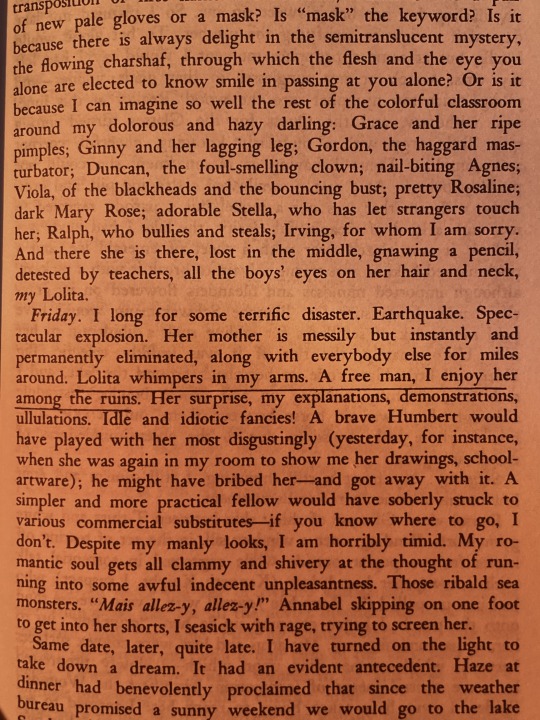
What is so incredibly impressive in Nabokov’s approach that I believe some authors should imitate is depicting a crime without making it pornographic. For a book that is basically a pedophile’s account, the scenes were not explicit or sensual. But since he aimed to write from the point of view of a man who finds this as aesthetically pleasing, the narrative is obscured in flowery language and metaphor. At one point, I could not gather whether he had already done it because of his attempts to pacify the reader with impressive writing. Even sickening was arguing that there was nothing wrong after all since Lolita was no longer a virgin.
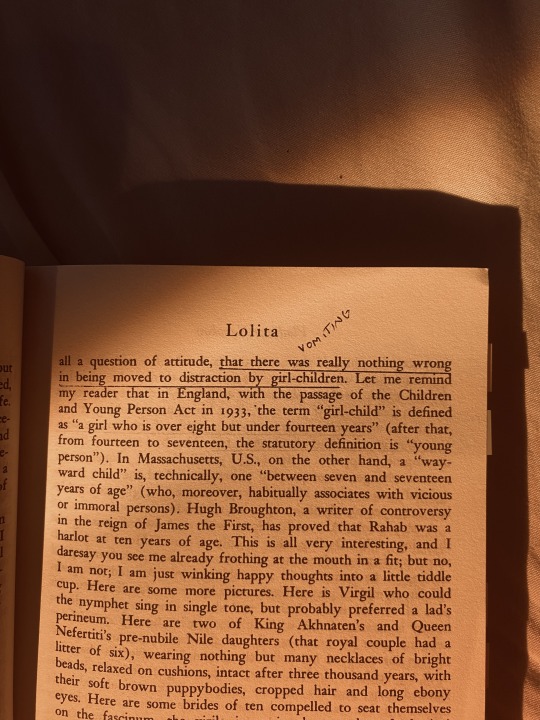
At the very core, Lolita is a horror story. I am quite appalled at the common general belief that it is a love story; that at some point, Humbert did love his little girl. ‘The tragedy lies in their unrequited romance.’ Nabokov would’ve risen from the grave. I would argue that, yes, while the rape scenes were subtext, and the author did not attempt to exhaust anatomical details, (actually, no matter how embellished a rape scene is with highbrow vocabulary and figures of speech, it’s an issue of skill for not arriving at the conclusion that he raped her, or perhaps a denial of one’s own true mental compass.) one paragraph from the novel struck me as a very obvious admission of guilt:

“Alas, I was unable to transcend the simple human fact that whatever spiritual solace I might find, whatever lithophanic eternities might be provided for me, nothing could make my Lolita forget the foul lust I had inflicted upon her. Unless it can be proven to me — to me as I am now, today, with my heart and by beard, and my putrefaction — that in the infinite run it does not matter a jot that a North American girl-child named Dolores Haze had been deprived of her childhood by a maniac, unless this can be proven (and if it can, then life is a joke), I see nothing for the treatment of my misery but the melancholy and very local palliative of articulate art.”
Humbert himself acknowledges that to otherwise admit he had ruined Lolita’s life is a joke. He would go to hell in any religion because of the foul lust he had inflicted upon her. And no being could prove to him that he did not deprive her of a childhood. No subtext needed. No desire for hints. So many paragraphs are evidence alone. Nabokov never painted Humbert in a color different from a monster. Many times he was clearly written like a pathetic loser who died as miserable as he was living. I believe Humbert’s account to have someone sympathize with him is in earnest, a hypocritical and narcissistic attempt to not hold himself fully accountable. And to point a finger at the author for being a ‘creep’ because of his depiction of abuse is quite ridiculous. Reading the book carefully would equip you with a crystal clear conclusion that depiction is not always endorsement. So to arrive at romanticizing the story, Nabokov does a good job of holding up a mirror to show confirmation that abuse can be in the form of romantic prose, that we lack the ability to set apart roses from blood.

This is perhaps one of the saddest books I have ever read. I hope all Dolores Hazes in the world find peace and happiness.
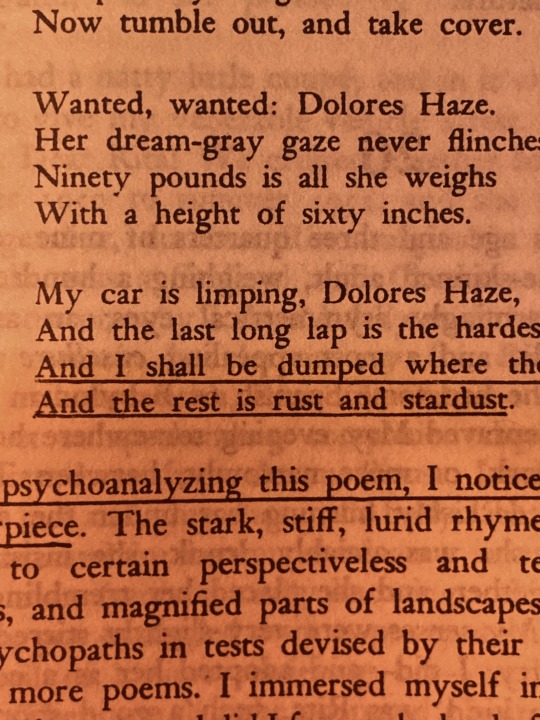
#bookreview#bookblr#bookrecommendation#vladimirnabokov#vladimir nabokov#classic literature#classics#classicbooks#bookshelf#bookquotes#bookstagram#banned books
5 notes
·
View notes
Text
Sorrow, Anna Ancher 1902 (Oil 86,3 x 73,8 cm)

Dolor, Anna Archer 1902 (Óleo 86,3 x 73,8 cm)
(English / Español / Italiano)
Sorrow. Necessary symbolism.
"There was a time when I lacked subjects to paint. I thought about this day and night. And then one night I had a dream. I saw under a cross in a cemetery the meeting of a mother and her daughter. The mother knelt down and the daughter bent over her. One of them had died. This encounter in the cemetery was so vivid for me that the next day I began to paint it. Anna Ancher
The Danish Anna Ancher (1859-1935) explained the reason for this work perfectly in an interview she was given when she was 70 years old, and perhaps explaining it takes some of the magic out of it. It is not always good for artists to explain their works to us, as they should speak for themselves, and take on a life of their own, and be the property of the spectators to interpret them as they please.
But we are talking about none other than Anna Ancher, one of the greatest artists in history, so maximum respect.
Ancher had always been a realist, using naturalist themes and language in her paintings (perhaps with some Impressionist overtones), but she had never before made use of such symbolism as in this work.
Death -omnipresent throughout the painting-, the landscape at sunset, the enormous cross, the contrast between the two women, the nude… all form a marvellous, shocking, symmetrical (or rather asymmetrical) whole.
On one side youth and beauty: matter. On the other, old age and darkness: spirituality... The cross divides these two women united by the pain that gives the work its title.
Incidentally, Anna Ancher used her own mother as a model.
-----------------------------------------------------------------------------
Dolor. Simbolismo necesario.
«Hubo un tiempo en el que me faltaban temas para pintar. Pensé en esto día y noche. Y entonces una noche tuve un sueño. Vi bajo una cruz en un cementerio el encuentro de una madre y su hija. La madre se arrodilló y la hija se inclinó sobre ella. Una de ellas había muerto. Este encuentro en el cementerio fue tan vívido para mí que al día siguiente comencé a pintarlo». Anna Ancher
La danesa Anna Ancher (1859-1935) explicó perfectamente el porqué de esta obra en una entrevista que le hicieron cuando tenía 70 años, y quizás explicándola, le resta algo de magia. No siempre es bueno que los artistas nos expliquen sus obras, ya que estas deberían hablar por sí mismas, y adquirir vida propia, y ser ya propiedad de los espectadores para interpretarlas como les plazca.
Pero estamos hablando de nada menos que Anna Ancher, una de las mejores artistas de la historia, así que máximo respeto.
La pintora se vuelve de pronto una simbolista a causa de un sueño. Ancher siempre había sido una realista, utilizando temáticas y lenguajes naturalistas para sus pinturas (quizás en algunas se hacía valer de algún matiz impresionista), pero jamás había hecho uso de algo de tanto simbolismo como esta obra.
La muerte —omnipresente en todo el cuadro—, el paisaje al atardecer, esa enorme cruz, el contraste entre las dos mujeres, el desnudo… todo forma un conjunto maravilloso, estremecedor, simétrico (o más bien asimétrico).
A un lado juventud y belleza:, materia. Al otro vejez y oscuridad: espiritualidad… La cruz divide a estas dos mujeres unidas por el dolor que da título a la obra.
Por cierto, Anna Ancher utilizó a su propia madre como modelo.
-----------------------------------------------------------------------------
Dolore. Simbolismo necessario.
"C'è stato un periodo in cui mi mancavano i soggetti da dipingere. Ci pensavo giorno e notte. E poi una notte ho fatto un sogno. Ho visto sotto una croce in un cimitero l'incontro tra una madre e sua figlia. La madre si inginocchiò e la figlia si chinò su di lei. Una di loro era morta. Questo incontro al cimitero è stato così vivido per me che il giorno dopo ho iniziato a dipingerlo. Anna Ancher
La danese Anna Ancher (1859-1935) ha spiegato perfettamente il motivo di quest'opera in un'intervista rilasciata all'età di 70 anni, e forse spiegarla toglie un po' di magia. Non è sempre bene che gli artisti ci spieghino le loro opere, perché esse dovrebbero parlare da sole, assumere una vita propria ed essere proprietà degli spettatori che le interpretano a loro piacimento.
Ma stiamo parlando nientemeno che di Anna Ancher, una delle più grandi artiste della storia, quindi massimo rispetto.
La Ancher era sempre stata una realista, che utilizzava temi e linguaggio naturalisti nei suoi dipinti (forse con qualche sfumatura impressionista), ma non aveva mai fatto ricorso al simbolismo come in quest'opera.
La morte - onnipresente in tutto il quadro -, il paesaggio al tramonto, l'enorme croce, il contrasto tra le due donne, il nudo… formano un insieme meraviglioso, sconvolgente, simmetrico (o piuttosto asimmetrico).
Da una parte la giovinezza e la bellezza: la materia. Dall'altra, la vecchiaia e l'oscurità: la spiritualità... La croce divide queste due donne unite dal dolore che dà il titolo all'opera.
Per inciso, Anna Ancher ha usato la propria madre come modello.
Source: HA! by Emilia Bolaño
#painting#19th century#20th century#s.XIX#s.XX#symbolism#impressionism#realism#simbolismo#realismo#impresionismo#anna archer
2 notes
·
View notes
Video
5 Signs Encountered ONLY By People With Spiritual Gifts ✨ Dolores Cannon
0 notes
Photo
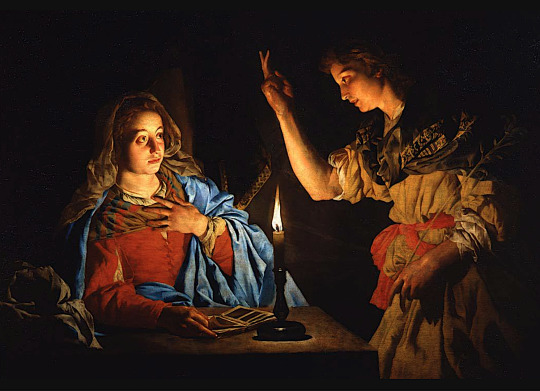

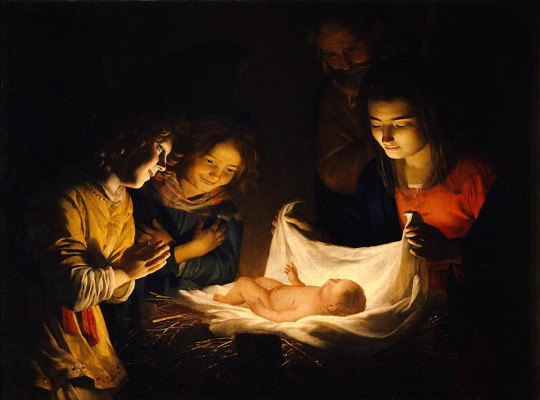
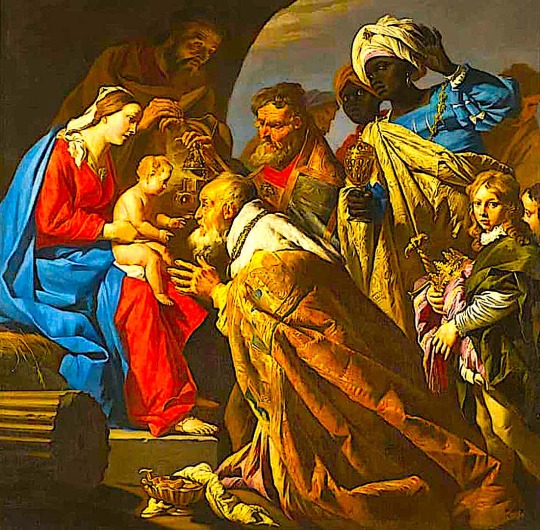
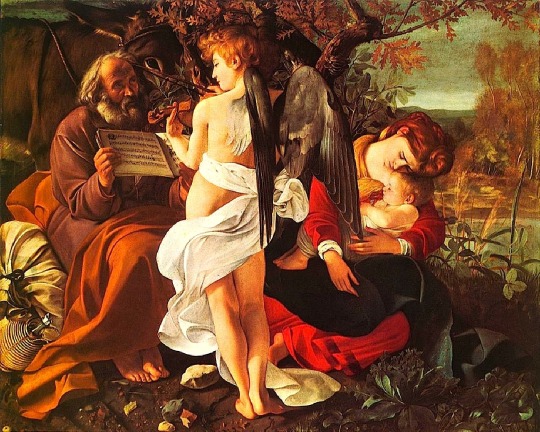
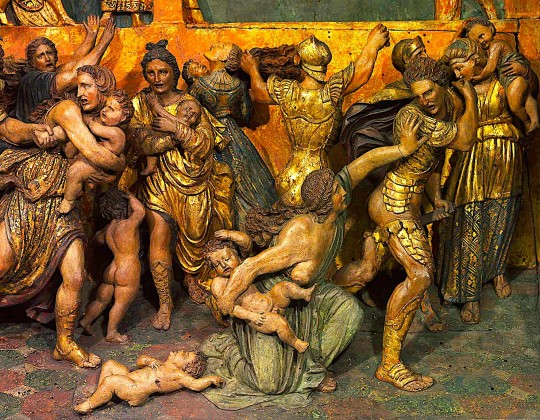
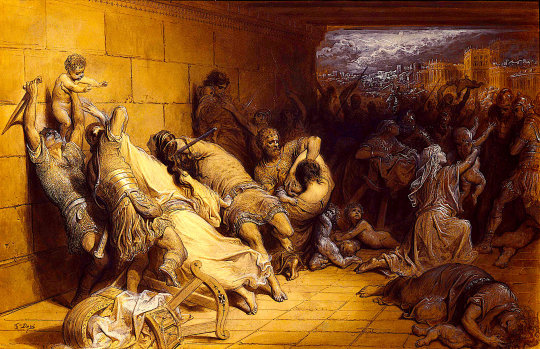
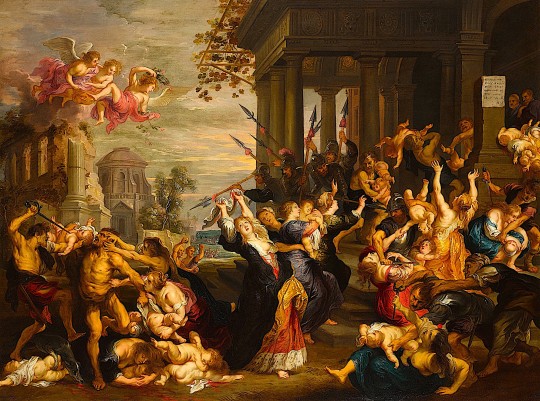
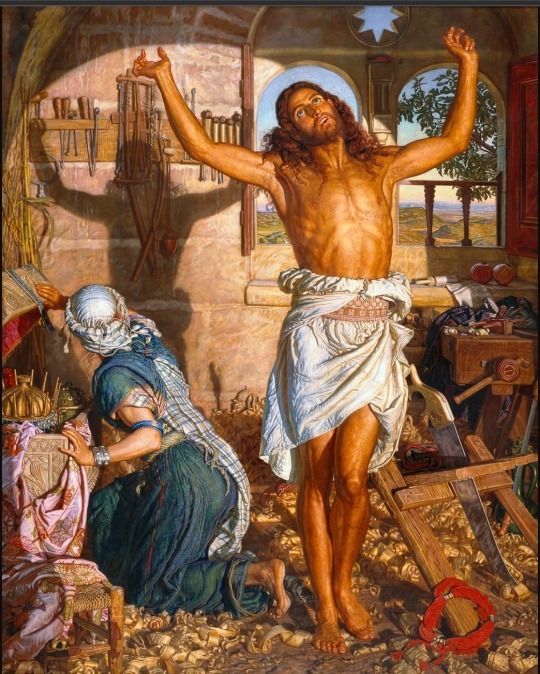

youtube
youtube
youtube
youtube
youtube
Gallery: 1 Hail Mary, Full Of Grace 2 My Soul Does Magnify The Lord 3 Shepherds Worship The Child 4 Adoration Of The Magi 5 The Flight Into Egypt 6 Rachel Weeping For Her Children 7 Massacre Of The Innocents 8 Herod Worships The Holy Child 9 The Shadow of Death 10 Baptism Of Yeshua
MESSIAH'S EASTERTIDE JUBILEE – revised & expanded Apr 21, 2023 – by David D. Fowler & Aeon 999
Welcome to MFF's 2022 Easter spectacular. Like our past efforts, this 7-part extravaganza features a well-stocked cornucopia of outstanding videos. Our purpose is to enhance the celebration of the glorious Eastertide tradition – from now, until the Eastern Orthodox Day Of Pentecost in June.
These items constitute the best available resources we could find online, representing many different views of Christ-based spirituality and artistic endeavors – as well as alternative spiritual paths, and articulate expressions of skepticism. We offer complete editions of many films, including secular productions that deal with themes such as the supernatural; good versus evil; human depravity; self-sacrifice; redemption; and superheroism, as a metaphor for salvation.
We present a generous spectrum of outstanding music – including rock, classical, black gospel, sacred choral, blues, jazz, and experimental performances. You'll also encounter a variety of hilarious videos, including some exceedingly irreverent items; and intense debates, focusing on fascinating and passionate takes on the myriad realities of Christ's impact on the world.
You’ll find a lot of iconic films, including BEN-HUR, THE MATRIX, LIFE OF BRIAN, LORD OF THE RINGS, HARRY POTTER AND THE PRISONER OF AZKABAN, BECKET, THE ROBE, LILIES OF THE FIELD, JESUS OF NAZARETH, AVENGERS ENDGAME, THE SEVENTH SEAL, THE MISSION, THE WIZARD OF OZ, JASON AND THE ARGONAUTS, THE WITCH, KING OF KINGS, THE MIRACLE MAKER, DOCTOR STRANGE, THE PASSION OF JOAN OF ARC, METROPOLIS, ELMER GANTRY, and HAMLET.
We also feature a number of less high-profile movies, such as MORTAL ENGINES, FAUST, DUNE, BARAKA, DAY OF WRATH, CONSTANTINE, STALKER, ORDET, WAR REQUIEM, JOHN CARTER OF MARS, THE WICKER MAN, INTOLERANCE, THE SACRIFICE, LESSONS OF DARKNESS, THE DAY CHRIST DIED, ANDREI RUBLEV, JESUS OF MONTREAL, NIGHT OF THE HUNTER, THE BOOK OF LIFE, THE MILL AND THE CROSS, TWIN PEAKS: FIRE WALK WITH ME, SILENCE, CLOUD ATLAS, and NOSTALGHIA.
You'll enjoy popular musicians, ranging from U2, BOB DYLAN, ELVIS PRESLEY, LEONARD COHEN, ARETHA FRANKLIN, BJORK, ALICE COOPER, JOHNNY CASH, JOAN BAEZ, and the ROLLING STONES, to BRYAN ADAMS, PRINCE, EMMYLOU HARRIS, TOM WAITS, DOLORES O'RIORDAN, JOHN LENNON, ANNIE LENNOX, BUFFY SAINTE MARIE, and BRUCE COCKBURN.
We also present legendary figures: PAUL ROBESON, WOODY GUTHRIE, ROSETTA THARPE, and MAHALIA JACKSON; and lesser-known musicians, such as IONA, PHIL OCHS, LOST DOGS, KATHY MATTEA, MARIA McKEE, KEITH GREEN, LARRY NORMAN, CAPTAIN BEEFHEART, the SWIRLING EDDIES, and the CHAMBERS BROTHERS.
We feature musicals: AMAHL AND THE NIGHT VISITORS, COTTON PATCH GOSPEL, JESUS CHRIST SUPERSTAR, THE GOSPEL AT COLONUS, and GODSPELL; jazz masters, such as JOHN COLTRANE, DUKE ELLINGTON, ARCHIE SHEPP, HORACE PARLAN, and LOUIS ARMSTRONG; and opera icons LUCIANO PAVAROTTI, TERESA STRATAS, and JESSYE NORMAN.
We showcase choral masterpieces by HANDEL, FAURE, MAHLER, BACH, BEETHOVEN, VERDI, BARBER, VIVALDI, ALBINONI, BRAHMS, HAYDN, ALLEGRI, BRITTEN, MOZART, BRUCKNER, PERGOLISI, IVES, VAUGHAN WILLIAMS, SCRIABIN, MENDELSSOHN, BERLIOZ, LISZT, TCHAIKOVSKY, RACHMANINOFF, and DVORAK. We also present the spectacular Bible-related visual works of CARAVAGGIO, GUSTAVE DORÉ, and MARC CHAGALL.
We explore controversial books, movies, and phenomena, such as: ZEITGEIST; THE GOD WHO WASN'T THERE; RELIGULOUS; MERE CHRISTIANITY; the PAGAN CHRIST; the SHROUD OF TURIN; the HOLY GRAIL; THE CELESTINE PROPHECY; THE DA VINCI CODE; the GOSPEL OF THOMAS; A COURSE IN MIRACLES; GNOSTICISM; THE SCREWTAPE LETTERS; PARADISE LOST; FLOWERS OF EVIL; and CHRISTIAN NATIONALISM.
Finally, we present a wide range of humor, from the likes of MONTY PYTHON, MEL BROOKS, LENNY BRUCE, NOT THE NINE O'CLOCK NEWS, GOOD OMENS, NEGATIVLAND, TOM LEHRER, LORD BUCKLEY, JOHN PRINE, FAMILY GUY, ROWAN ATKINSON, MIRACLE WORKERS, LUCIFER, PREACHER, CRACKED, BETTY BOWERS, VIC BERGER, and SATURDAY NIGHT LIVE.
We think you will get considerable entertainment from many of these materials – and maybe also encounter unexpected eloquence, edification, and enlightenment. We strive to offer works of art that will challenge people's thinking; motivate folks to rise above everyday petty concerns; inspire us all to maintain hope, love, encouragement, and dignity in this fragile world; and perhaps even help open-minded unbelievers find good reasons to believe that Christ is risen indeed.
So we invite you to kindly bookmark this post – and check out the sections below at your leisure. If you derive something of real value from our playlists, we would be delighted if you share them with your friends. We extend our best wishes for an uplifting exploration of spirituality, as the Easter season unfolds. God bless y'all!
Jubilee part 2: THE HOLY SPIRIT TRAVELING IN DISGUISE https://musemash.tumblr.com/post/46758040906/messiahs-jubilee-part-1-the-spirit-in-disguise Jubilee part 3: HEATHEN DANCE PARTY IN PURGATORY https://musemash.tumblr.com/post/164579528390/jubilee-part-3-heathen-dance-party-in-purgatory Jubilee part 4: HOPE IS STRONGER THAN DEATH https://musemash.tumblr.com/post/615204082966233088/hope-is-stronger-than-death-revised-updated Jubilee part 5: COLLISIONS OF ALL OUR TRUTHS https://musemash.tumblr.com/post/46757984172/messiahs-jubilee-part-2-collisions-of-all-truths Jubilee part 6: SHAPE SHIFTING MASQUES OF REDEMPTION https://musemash.tumblr.com/post/46757919841/messiahs-jubilee-part-3-masques-of-redemption Jubilee part 7: MAKING JOYFUL NOISES UNTO THE LORD https://musemash.tumblr.com/post/46757864172/messiahs-jubilee-part-4-joyful-noises-unto-the
10 notes
·
View notes
Text
Possession 1981 review (I’m still digesting so this is very surface level)
Prelude: I’d actually seen parts of this a long time ago while channel hopping, if you’ve been following for a while you’ll know that in my late teens/early adulthood I had severe insomnia and would get up and watch TV once everyone had gone to sleep. 10pm is when you get your interesting stuff like shows like Queer as folk, 11.30 the second more artsy film of the night, by the time it’s 2 am: there’s the shopping channels, fishing and hunting (”chasse et pêche” filmed seemingly in real time) soft porno and Arte. Arte (see their youtube) is a franco german channel that show all sorts of culture, history, travel documentaries during the day, a prestige film at 9 and arthouse after that. Their reporting is top notch and Tracks has been a great primer for various subcultures for twenty years. That’s where I saw a lot of boring, wonderful and odd stuff like this that didn’t click and upset my brain so I channel hopped and remembered just a few scenes/feelings.
First Thoughts: I went into this “knowing” it’s an allegory for divorce and the divorce of being exiled. We see very little of Berlin really, it’s about the white appartment nightmare prison and the echo-y cold wide emptiness of the second appartment. Berlin’s more the child of divorce city with a wall down the middle and the threat of nuclear war hanging over it. I wasn’t disturbed by the sex or the violence, it sort of flows with the dizzying madness. I was disturbed by the odd sense of time, it’s not even clear if the story is linear or reliable.
What sticks with me as most painful is a scene in ballet class, the casual sadism and cruelty of a particular kind of ballet, what Anna probably went through herself and inflicts on this girl - It’s unbearable to watch. Then that glimpse of the true Anna and her loss of self between all the small roles she plays for others. She’s not been herself for so long. Like Lolita this is the story of Mark and how he sees Anna but Anna, like Dolores, is begging for us to find her in the details. She tells us she’s mentally splitting between Faith and Chance, two distinct philosophies: she births/miscarries faith and nurtures it with murder into a perfect Mark doppleganger. Very Saya no Uta of her. But it’s also implied that her Faith side could be a doppleganger. She is desperate to break free to reject her mental chaining like a frenzied rabid dog the entire film.
Mark goes through a whole journey of getting drunk, not listening to his wife, just wanting ownership and normalcy, hating her new lover, not caring about the lover, deciding he doesn’t care that much as he doesn’t know her really then rediscovering he loves her or at least wants to protect her around the point when he finds the bodies. He’s even more hard to understand, he feels entitled to someone he’s estranged from, he seems to soften at some point then he thinks he’s won his wife over when the lover is injured after that who knows what’s animating him. I can’t tell if he lost his mind and imagined the end. His encounters with Heinrich have oddly charged energy.
It’s unclear if the personality traits abandoned by Anna into Helen meeting the personality traits birthed/sexed into Mark2 causes the end of the world. The final scenes are the most confusing. The film moves in spirals: the camera, Mark and Anna circling eachother... and time.
They both want something real, they can’t hear eachother. The town seems like their private place and yet they are completely exposed and watched even in their own spaces. the lack of boundaries is unsettling right until there’s a door to open.
more thoughts later. I feel like this more about the spiritual than the emotional. About wife and mother being roles, about how both soviet and christian culture turn these roles into bondage. How what is evil is not always harmful and what is good can be very harmful and we’re mentally breaking if we try and live according to good and evil as defined by others.
This music video is what convinced me to rewatch and fits both characters so well: tw: gore, insanity, fluids, vomit, nudity, domestic violence, self harm, miscarriage (of sorts)
youtube
6 notes
·
View notes
Note
if i had to choose, i'd love to see a telenovela-style or influenced animateed show about the madrigal family. it would be about dolores and mariano started from right after she accepts his proposal and all the family dynamics stretching and twisting as their family gets even bigger. and maybe it would show how the madrigals also interact with their other relatives since they would have to come for the wedding, and every good telenovela wedding is messy with everyones' secrets spilling out. i don't think disney would ever do anything as dramatic as "¿¡que haces besando a la lisiada!?" but we can only dream. either that or it would be more fantasy adventure-based. like, antonio might encounter or be taken away by duendes and camilo, whose shapeshifting ability is similar to other creatures in folklore, and dolores go with some others to find him. but maybe because antonio's gift could have a connection with spirituality and animism through animals, he could become so in tune with nature after living with the different kinds of duendes, that he decides he doesn't want to leave them. child custody battle between fairies/animals and the madrigals.
Oh, you could have both things at the same time! Like you will have the Madrigals sometimes dealing with fantastical adventures themed around Colombian folklore, while also having episodes about their everyday life and their dynamics with the townspeople. Like, we already accept that the miracle is real and these people have powers, so it wouldn't be stretch at all to have fantastical creatures around. THEN, just as a treat, you sometimes cut to the rata telenovelas of Bruno with it's ridiculous and over the top plot full of twists and cliffhangers that you have to tune in to follow. Maybe down the line it's revealed his rata telenovelas are like puppet shows that he makes for the children and slowly getting more of a following.
3 notes
·
View notes
Text
yet more on disability in Malory’s Le Morte d’Arthur
for anyone who is interested in the topic, this posts continues to summarise Sitting on the Sidelines: Disability in Malory by Kristina Hildebrand - same as always, cw for both in-text and out-of-text ableism, and also a note that i’m disabled and the views expressed in this article don’t necessarily align with mine ⚔️ 🏰
previous posts can be found here:
introduction
Sir Urre
Part 3 - King Pellam (and the Grail Quest as a story of disability)
in every Arthurian romance, the basic plotline of the Grail Quest involves the Grail King (often called the Fisher King) being wounded and then healed many years later by the Grail Knight (either Galahad or Percival)
this Grail Quest in Le Morte d’Arthur can be seen as a story of disability - from its first appearance, the Holy Grail renders the Round Table “mute” and causes a certain sort of “blindness” (they cannot see the Grail clearly). This “blindness” motivates the quest (they desire to be “cured” and see the Grail):
The Grail... is always already linked to the disabled body. When the Grail appears before the Round Table knights for the first time, disability marks its arrival in two ways. First, the knights are struck mute just prior to its appearance. Moreover, the knights suffer a kind of blindness in its presence; no one is able to clearly view the Grail, and it is this inability that inaugurates the Grail Quest: they vow not to return until they have ‘sene hit more opynly'. Disability thus serves as the Quest’s motive and objective: to see what cannot be seen, or, in effect, to cure impaired vision.
Malory repeatedly associates the Grail Quest with the disabled body through the Grail King(s) (and other kings/knights encountered during the quest). His text has a lot of repetition and alteration in this context, with two ‘maimed kings’ (and a separate Fisher King) and three ‘dolorous strokes’ (“maiming” attacks) - this isn’t a case of similar names and themes popping up again, but rather previous asides/plot points being bought back with noticeable differences.
Maimed king (1)/Dolorous stroke (1) - Pellam is introduced early on*. He is wounded by Sir Balin and his lands waste as a result (common Grail King narrative), which is why the blow Balin dealt is referred to as a ‘dolorous stroke’. In this way, disability is spread from a ruler to the land he rules. The text explicitly states that he remains wounded until he is healed by Galahad during his quest for the Grail (foreshadowing for later)
* (this story also links to one medieval conceptualisation of disability (among several), which is ‘impairment’ as judgement for sin. Pellam appears later as the Grail guardian, a positive spiritual figure, so it is unlikely that it is his sin that is being punished. Instead, it may be a punishment for Balin’s sins, albeit visited on the wrong body)
Dolorous stroke (2) - The dolorous stroke is brought up again in the Grail story, when King Hurlaine kills King Labor. This act leads to both of their realms becoming wastelands.
Maimed king (2)/Dolorous stroke (3) + Fisher King - the maimed king returns with a name change (Pelles instead of Pellam). Here he is King of Corbenic (Carbonek), Elaine of Corbenic’s father, and consequently Galahad’s grandfather. This family link is important to note, as earlier King Pelles of Corbenic appears in the text, unwounded and unmaimed. The way in which he is wounded also changes from Pellam’s story, instead involving the sword used to kill King Labor and a spear. Furthermore, when Galahad arrives at Arthur’s court, he mentions his grandfather Pelles and the Fisher King as two separate people living at Corbenic.
several other characters exist that participate in the thematic function of the maimed Fisher King:
King Evelake (400 years old, encountered by Percival, healed by Galahad)
King Mordrayns (blind, restored to youth as he is healed by Galahad, promptly dies in his arms)
the ‘Maymed Kyng’ (sick, lives at castle Corbenic but is not King Pelles, healed with blood from the spear that accompanied the Grail - might be the Fisher King already said to be living there with Pelles)
old man in Sarras (needs crutches, healed by Galahad)
interesting to note that King Pelles is never healed on the page - and may not have been healed at all. When the Grail knights leave Corbenic, it is still referred to as the place of the ‘Maymed Kyng’ (whether this is the unnamed Maymed Kyng or King Pelles is unclear). Because all of these disabled kings share the Fisher King’s thematic function, Pelles doesn’t have to fulfil that function by being healed.
these sort-of Fisher Kings share two characteristics associated with disability and the Middle Ages: liminality of the impaired and the potentially positive outcome of impairment
1) the potentially positive outcome of impairment - if not brought about by sin, illness/impairment could be seen as a form of cleansing and spiritual healing. Some of the maimed kings (e.g. Evelake) are injured due to sin, but many of them can still be seen as examples of “purification through suffering impairment”. They are all close to the Grail, are seen praying, and await healing by Galahad (who they know is coming):
Disability in Malory can be caused by evil magic, by sin, or by too presumptuous a desire for the Grail, but it also consistently represents penance, purification, and the grace of God.
2) liminality of the impaired - the maimed kings inhabit liminal space; unlike with Sir Urre, they often don’t leave liminal space to become part of the community after being healed, but die instead. They also exist in this liminal space for more reasons than disability...
the Grail quest is different from the other quests and adventures in Malory’s text. The rules are different in this liminal world, where only virtuous living can bring the knights success, not chivalry or prowess. It is a space where God can be seen (e.g. at Mass the Eucharist turns into a child and then back into bread), and it is a space for leaving - only the Grail guardians and servants can remain, while the knights either die or exit the space:
It is also a liminal space in that it has to be left: the knights cannot remain within it. Some return to Camelot, some are killed, and some die peacefully and enter heaven, but the liminal space can only be temporarily inhabited by all except the Grail's guardians and servants—many of whom also exhibit the liminality of disability.
like Sir Urre, the disabled Grail guardians cannot participate in the chivalric community - but unlike in Urre’s story, the chivalric community here is broken. Knights fail to recognise each other and end up killing one another - the chivalric community can’t exist in this liminal space. They are transformed in this liminal space, just as disabled bodies are sites of transformation:
The knights' bodily ability, which has defined them before and will again in the story of Sir Urré, here avails them nothing. Their bodies are moving through a liminal landscape, where some will be transformed by holy orders or by death. The guardians of this Grail landscape are thus permanent inhabitants of the liminal, and their disabilities may be seen as representing a place where bodies are in constant transformation, moving towards death, sacredness, or bliss.
The inconsistency/confusion in the Grail narrative may be due to the discomfort Malory and his audience feel regarding disability and disabling injuries, and the threat they pose to their membership in knightly society and to their able-bodied image:
The confusion surrounding a character, like the Grail king - traditionally portrayed as, and even defined by, his disability - indicates a deep discomfort with the subject. I would claim that the invisibility and confusion surrounding disability in Malory's text is due to its being non-normative, and thus marginalized to the point of invisibility in the text, and that this, in its turn, is due to its being a site of anxiety for the intended audience.
Conclusion
Disability slips through the text, away from the reader's attention, and is seen only at the moment of restoration. The focus remains on the restorer, not on the disabled character, who cannot occupy a central place in the text. When the character moves nearer the center, like Pelles does in the Grail story, the disability cannot co-exist with centrality, and thus becomes invisible. Existing in liminal space, forced out of the chivalric community, the disabled knights can no longer partake in the pursuits that define them as knights. They sit on the sidelines as the story inexorably moves away, retaining the able-bodied at its center.
#Arthuriana#disability#arthurian literature#Le Morte d'Arthur#sir thomas malory#the holy grail#grail quest#grail knight#King Pellam#The Fisher King#*#ableism#medieval literature#resources#knights#Corbenic#Galahad
5 notes
·
View notes
Text
[ LFRP ] Canary - ( tumblr/Discord )
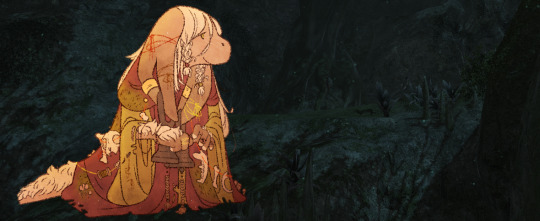
❝ we who are born of the earth, rooted in all things, are bound to return to it. ❞
🔓– A lock icon denotes the presence of an additional something significant to be discovered only via roleplay. The more locks there are, the more difficult it will be to learn or come by this information.
☾ General Information ––– -
Name: Canary. 🔓🔓🔓 Epithet: Lichenpeal. Gender: Nonbinary. Age: You can’t be sure, really. 🔓 Race: Nu Mou. Birthplace: Somewhere within the Rak’tika Greatwood, presumably. Current Residence: An overgrown hovel a way’s away from the settlement proper. Were it not for the stone arranged about it, you might have missed the doorway entirely, and even then the masonry has been all but reclaimed by the forest. It seems built into the earth itself, disappearing into the side of the gentle slope leading up and away into the trees... not too unlike a barrow, you realize, with the air around the entrance alive with the presence of the wood. Standing there you suddenly feel a strange tickling at the back of your neck, like a hair or thread dragging lightly across your skin. You look back up. You feel compelled to knock on the door. Relationship Status: Single. Sexual Orientation: Asexual. Occupation: Apothecary. Herbalist. Diviner. Blue Mage. 🔓
☾ Physical Appearance ––– -
Hair + Fur: Straw-colored Thick. Long. Worn loose save for a scattering of braids decorated with thread and bits of bone. The fur on their tail and arms appears crimped like a sheep’s wool and feels much like the same. It’s not unusual for both it be rather unkempt from walks through the wood; they don’t seem to mind the twigs, leaves, and clumps of dirt that cling to them long after they’re home. Eyes: Moss green... although, as you look more closely, the left eye seems lighter than the right. Height: 4 fm 9 im. Distinguishing Marks: White-tipped fingers. Claws that are kept aggressively filed down at all times. Lighter hands than is typical for Nu Mou. Common Accessories: Spools of variously colored threads. Skulls and bones from forest creatures worn on lengths of string. Mushrooms. Lichens. Gold earbands. Earrings fashioned in the style of old church bells that ring with deep, dolorous voices.
☾ Personality & Tidbits ––– -
A strange Nu Mou of indeterminate age beholden to the wood. Though they live apart from others of their kind and people in general, they receive most visitors with a smile and an invitation to share a cup of tea. Quiet and courteous, Canary seems very much the kind of host you would care to have out in the middle of the wild Rat’tika, and yet you cannot help but feel unsettled whenever you stare at them for too long -- as though discovering inconsistencies in a painting that prove it a forgery. Like a smile with too many teeth their presence fills you with the sense of the uncanny, reminding you of a delicious meal that puts you to ill hours later. Something about them seems the conversational equivalent of seeing something always just beyond your field of vision, just at your peripheral, but just as soon as you realize your uneasiness you feel yourself soothed by their comfortable, welcoming manner. After all, it feels this cup has been brewed just for you.
Talents: Tarot spreads. Tea readings. Preparation of herbal medicines. Communing with beasts. Weaknesses: Disruption of the natural order. Things that are unnatural. Voidsent. Tidiness. Virtues: Pleasant. Soft-spoken. Knowledgeable. Intriguing. A natural host. Flaws: Difficult to read. Quietly intimidating. Unmovable when they believe they are right. Perhaps too much of an enigma to be trusted. Spiritual Views: Absolute reverence for life, death, and the natural cycle of one that leads into the other and over again forever and always. They are bound to no specific deities, believing instead in the will of the wood and the inevitability of nature reclaiming that which is rightfully its own. Hobbies: Gathering. “Tending” their garden and mushroom patch. Collecting new teas and bones. Fears: Wide open spaces. Clothing without pockets. Temperament: Phlegmatic-Melancholy. Alignment: Chaotic Neutral.
☾ Traits ––– -
Extroverted / In Between / Introverted
Disorganized / In Between / Organized
Close Minded / In Between / Open Minded
Calm / In Between / Anxious / Spirited
Disagreeable / In Between / Agreeable
Cautious / In Between / Reckless
Patient / In Between / Impatient
Outspoken / In Between / Reserved
Leader / In Between / Follower
Empathetic / In Between / Apathetic
Optimistic / In Between / Pessimistic
Traditional / In Between / Modern
Hard-working / In Between / Lazy
Cultured / In Between / Uncultured
Loyal / In Between / Disloyal
Faithful / In Between / Unfaithful
☾ Additional information ––– –
Smoking Habit: Rather often, but you’re certain what whatever it is in that pipe, it certainly isn’t tobacco. The fragrance is as uncomfortably sweet as it is spicy; the aroma makes you sick to your stomach. Drugs: The contents of all these vials and jars is a mystery. Whatever labels they once bore have long since worn away or peeled up, leaving you staring at an array of dull, clouded glass bottles haphazardly wrapped in brittle parchment. Really, anything could be inside them. Alcohol: The Nu Mou occasionally reaches for a flash tucked into the sleeve of their robe and takes a quick drink. You can’t see the liquid, but even from here the smell is pungent, and you swear you see the already crimped fur covering their body curl all the bit more with each swig.
☾ Hooks ––– -
Region-related connections.
☆ The Rat’tika Greatwood - The Nu Mou rarely strays beyond the border of the forest, and so those living under the boughs or visiting from afar might have the luck of crossing their path. They do not make it easy to find them, but they also do not make an effort to hide. If you’re meant to encounter them you surely will. After all, anything can happen in the wood...
General connections.
★ Blue Magic - Canary’s Blue Magic shares far more in common with FFXI’s iteration than FFXIV’s, most notably the ever present danger of falling prey to “the beast within” as they assimilate and make use of the essences/souls of creatures. As a result their magic is far more feral and ancient than what has been established in-game, and their combat style + weaponry also differ wildly. They will not give out this knowledge to just anyone who comes by and asks, but they are also not above it... Should someone be willing to prove themselves worthy of the art, Canary might potentially teach them. Barring this, they could be a potential connection for Blue Mages or magic-users in general. ☆ Medicines + Divinations - In need of a reading or some traditional mending? Canary peddles their strange wares out of their forest hovel for a fair price. First divinations are free -- considering it your proper meeting -- but subsequent knowledge requires something equal in exchange... ★ Friendships + Rivals + Enemies - Always open! I am interested in any and all of these as options. ☆ Have an idea for something not already here? - Please feel free to pitch it to me! I would love to hear what you have in mind!
☾ OOC Information ––– -
Genres: Character development! Platonic relationships! Business contacts! Enemies! Rivals! Spooks! I’m into lots of things with my dirty danger muppet! Playstyle: No Nu Mou in-game, so all roleplay with Canary will take place through tumblr and/or Discord. Length: I like to write one paragraph at the absolute least, tending more towards a few to several (or even pages), but I will often do my best to match my partner’s reply length unless encouraged to do otherwise. Server: N/A. Timezone: CST. Availability: Threads will be passed back and forth as our schedules/writing mojos will allow! Contact Information: You are always welcome to poke at me here or my main blog over at @sunlitpeony, be it through asks or messages! I will give my Discord out privately to interested parties.
ft. art by drowsydraws !
22 notes
·
View notes
Text
Para hacer realidad los sueños mas inteligentes...
Rumbo a la Luna nueva en Escorpio
Cambio es una palabra una idea, una realidad natural en mi humilde opinión que en mi vida personal me costo tiempo, paciencia, sensibilidad y dolor de cierta forma llegar a comprender. Sin embargo al aceptarlo e integrarlo a mi vida diaria espiritualmente, emocionalmente me ha ayudado a sentir paz, gratitud y fe en mi, mas a menudo hablarme con una voz mas gentil, interiormente y en consecuencia hablarle a quienes me rodean de la misma forma (no siempre he sido así ahaha tengo un caracter fuerte, agresivo incluso entonces para mi ha sido un logro importante).
Aquí en Colombia tenemos un dicho tradicional ¨Matar dos pájaros de un solo tiro¨ y eso es un ejemplo para explicar que al integrar la aceptación del cambio en mi vida he comprendido el significado de otro concepto que en mi opinión tampoco valoramos lo suficiente tal ves por condicionamiento o toxica influencia social, tal ves simplemente por miedo a sentir mas que a pensar... Es la pasión, un deseo mas allá del ego, un impulso casi infantil, muy autentico que nos desdibuja limitaciones y realidades muy pesimistas, creo que al estar inmersos en un pasión (y no me refiero a un sentido solo sentimental o romantico) que puede ser artistica, espiritual, simbolíca, profesional, intelectual o si en algunos maravillosos casos romanticá, el tiempo desaparece... Logramos vivir eternidades en horas, el dolor se asume con paciencia por que vale la pena el sacrificio, que mas que con sufrimiento como en el #Yoga el ballet, fitness, la danza o muchas otras practicas que implican el trabajo corporal, se transforma en un ejercicio de paciencia para aprender a comprender la naturaleza de lo que nos lastima y nos excita, lo que nos construye o destruye... La pasión se vive sin obligación, sino por algo más parecido a la lealtad me parece... una especie de fuerza interna que nos empodera frente a ideas, metas y sueños que existen solo en planos y realidades invisibles.
Cambio + Pasión en #Astrología es el Axis / Yin y Yang de #Acuario + #Leo ósea El Sol/Apolo para los griegos y Urano/Uranos la mitología nos ayuda a comprender fenómenos personales en términos mas cosmogónicos (como es arriba es abajo) usando arquetipos (imagenes primordiales de sensaciones y percepciones que se han repetido consecutivamente en la historia de la humanidad, en otras palabras aquellos roles/personajes presentes en todas las mitologías/folclor y religiones humanas, dios bueno, malo, héroe, villlano reyes y reinas ángeles o demonios etc.)
Esta semana el clima energético se presenta como un test emocional que nos ayuda a observar en nuestros mundos personales, que tanto conocemos el lado sombra de nuestras pasiones, deseos y relaciones, es una semana de transformaciones que comienzan, terminan o reciben un fuerte impulso, en asuntos como:
Dimensión material -- dinero, personal o compartido, posesiones, inversiones Dimensión emocional -- procesos psicológicos, situaciones que nos hacen terapia de shock frente asuntos negados, ignorados o reprimidos, pasiones sexuales Dimensión espiritual -- encuentros Karmicos, pendientes, reaparecen personas o personajes que nos recuerdan lecciones emocionales no reconocidas/reprimidas/negadas o sobre asuntos de poder, miedo y en la onda linda transformación de todos esos temas densos
Ojo! : Esto no es negativo al contrario cuando vemos el lado sombra de nuestra dimensión, comprendemos vemos la luz, nuestra naturaleza es plural por eso aceptar lo que nos tensiona como la oportunidad de crear una nueva perspectiva, es aprendes a transformar el miedo en amor en mi humilde opinión
Cuando estudie Astrología Mauricio Puerta mi maestro firmo uno de sus libros ahora míos, con una dedicatoria que dice: Para Juliana, que haga realidad sus sueños mas inteligentes... Hoy con este primer articulo de opinión, reflexión y chisme Astral en el día de Mercurio, mi intención es la misma, darles un Tip energético, interpretativo de la situación, invitarlos para que lo usen de herramienta para reflexionar como integrar esos símbolos Acuario - Cambio y Leo - Pasión puede alimentar hacer sus ilusiones y metas mas inteligentes, realidad.
Feliz semana!
To make smarter dreams come true ...
Heading to the new moon in Scorpio
Change is a word an idea, a natural reality in my humble opinion that in my personal life cost me time, patience, sensitivity and pain in some way to come to understand. However, by accepting it and integrating it into my daily life spiritually, it has emotionally helped me to feel peace, gratitude and faith in me, more often speaking to me with a more gentle voice, inwardly and consequently speaking to those around me in the same way ( I have not always been that way ahaha I have a strong, aggressive character even then for me it has been an important achievement).
Here in Colombia we have a traditional saying "Kill two birds with one shoot" and that is an example to explain that by integrating the acceptance of change in my life I have understood the meaning of another concept that in my opinion we do not value enough as you see. by conditioning or toxic social influence, perhaps simply because of fear of feeling, more than thinking ... It is passion, a desire beyond the ego, an almost childish impulse, very authentic that blurs us limitations and very pessimistic realities, I think being immersed in a passion (and I do not mean a sentimental or romantic sense only) that can be artistic, spiritual, symbolic, professional, intellectual or if in some wonderful romantic cases, time disappears ... We manage to live eternity in hours , the pain is assumed with patience because it is worth the sacrifice, that more than with suffering as in the #Yoga ballet, fitness, dance or many other practices that involve work body garlic, becomes an exercise in patience to learn to understand the nature of what hurts and excites us, what builds or destroys us ... Passion is lived without obligation, but for something more similar to loyalty it seems ... a kind of internal force that empowers us against ideas, goals and dreams that exist only on planes and invisible realities.
Change + Passion in # Astrology is the Axis / Yin and Yang of #Aquarius + #Leo bone The Sun / Apollo for the Greeks and Uranus / Uranus mythology helps us understand personal phenomena in more cosmogonic terms (as above is below) using archetypes (primordial mages of sensations and perceptions that have been repeated consecutively in the history of mankind, in other words those roles / characters present in all mythologies / folklore and human religions, good god, bad, hero, villain kings and queens angels or demons etc.)
This week the energy climate is presented as an emotional test that helps us observe in our personal worlds, which we know so much about the shadow side of our passions, desires and relationships, it is a week of transformations that begin, end or receive a strong impulse, on matters such as:
Material Dimension -- money, personal or shared, possessions, investments Emotional Dimension -- psychological processes, situations that make us shock therapy against denied, ignored or repressed issues, sexual passions Spiritual Dimension -- Karmic encounters, pending, people or characters reappear that remind us of unrecognized / repressed / denied emotional lessons or about issues of power, fear and the beautiful transformation of all these dense issues
Important! : This is not negative on the contrary when we see the shadow side of our own dimension, we understand, how see the light, our nature is plural that is why accepting what stresses us as the opportunity to create a new perspective, is learning to transform fear into love in my humble opinion
When I studied Astrology Mauricio Puerta, my teacher signed one of his books now mine, with a dedication that says: For Juliana, make her most intelligent dreams come true ... Today with this first article of opinion, reflection and Astral gossip on Mercury Day, my intention is the same, to give them an energetic Tip, interpretive of the situation, invite them to use it, as a tool to reflect how to integrate these symbols Aquarius - Change and Leo - Passion can feed make your illusions and goals more intelligent, reality.
Happy week!
1 note
·
View note
Text
Dispatches from the inaugural Magickal Women Conference, London

The inaugural Magickal Women Conference took place last week in London, on the first, sweltering day of June, and I was lucky enough to attend this ensorcelled summit, lipstick on and press pass in tow.
This was a landmark occasion in occult x academic (occademic?) circles, a groundbreaking gathering of female experts from various disciplines and traditions. So many magical women (and their men friends) under one roof! Little wonder then that the air was palpable with excitement when I arrived, stepping through the bustle of the foyer.
Tickets for the event at South Kensington’s Queensgate Center – a huge, bright, (accessible) rabbit warren of a venue – promptly sold out, and since most of the master classes and workshops were at full capacity, I spent the majority of the day in the main hall, drinking in the combined wisdom of the day’s speakers.
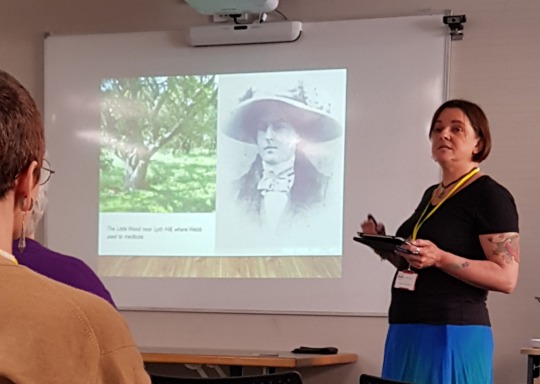
[Rebecca Beattie on the nature mystic novels of Mary Webb and Sylvia Townsend Warner]
There was a wealth of occultural knowledge on show throughout the day. My own personal highlights included the opening speech by esoteric doyenne Dolores Ashcroft-Nowicki, who gave us levity (“I’ve done ritual dress and I’ve done ritual undress”) and gravity in equal measure. I was deeply moved by Ashcroft-Nowicki’s words on what it means to survive. She urged us to think about our ancestors spiritual and genetic alike (a theme echoed throughout the day, in other talks): “We are here today because of those who came before us.”
As a working-class witch who spends a great deal of time thinking about lineages of survival, I appreciated this affirmation. I was grateful for writer, speaker and Secret Lore of London editor Caroline Wise’s comments on class privilege during her talk (on Fellowship of Isis founder Olivia Robertson). As a queer witch, I was also glad to hear Wise highlight the lesbian women who were – and perhaps continue to be – marginalized by Wicca’s historical emphasis on heterosexual hierarchies within priest x priestess-led covens.
Keynote speaker Christina Harrington-Oakley (founder of Treadwells bookshop) also touched on privilege, focussing on issues of property, ownership and leadership (#WhoOwnsTheLease) in both historical and contemporary occult communities, using the Battle of Blythe Road as an example. I was thrilled to hear her thoughts on power and gender in occult circles and how she – and we – might navigate toxic masculinity when it rears its ugly. She followed this up with a poignant reality check on the many obstacles facing the female practioners of my generation: growing wealth disparity; precarious housing; and a lack of IRL magical spaces we might access, let alone own. I enjoyed her nod to “pushing back the furniture” and the way women continue to map an arcane sphere over the domestic one.

[Treadwells’ Christina Harrington-Oakley, giving the keynote speech. Photo credit: Jenn Zahrt]
While Harrington-Oakley emboldened us to reclaim our ground, Shamanic practitioner Caitlin Matthews inspired us to find our song. When a logistical set-back temporarily halted her talk, Matthews’ showed us how an unplanned interruption might be transformed into a moment of transcendence, uniting us all in spontaneous, wordless song. What a thrill, to fill that cavernous white hall with the rising thrum of our collective voices! If Matthews invited us to send our song into the world, Alkistis Dimech (dancer, choreographer and Scarlet Imprint founder) prompted us to embody our magic via a rousing speech on anatomy, movement, science, sex, gender and “the occult body, which is the female body…the overlooked female body.” Like Ashcroft-Nowicki, Dimech is also concerned with survival; she was the sole speaker I encountered who referenced the very real threat of human extinction. Dimech’s presentation was both salutary and a call-to-arms, and I found myself delightfully overwhelmed by the time the afternoon drew to a close, giddy with inspiration, flush with new ideas and in the spellbinding company of new friends. I’m sure everyone who attended this lovingly curated event felt the same way.

Huge, witchy gratitude to Sue Terry and Erzebet Barthold (pictured above, photo credit: C. Terry), who magicked this event into life. Bring on MagickalWomen2020!
4 notes
·
View notes
Photo

Today is the birthday of Dolores O’Riordan, late singer of The Cranberries. Like many cinema geeks who don’t listen to much radio, my first encounter with her music was through Faye Wong’s cover of the chorus-less “Dreams” in the great film CHUNGKING EXPRESS (1994); both versions are essentially the platonic ideal of getting the best out of the dream pop and mainstream pop traditions simultaneously. During a long dark chapter of my life when I found myself consigned to working in a grocery store which constantly played extremely horrible alleged music nearly all of the time, it was always a celestial balm when one of the two Cranberries songs they had in the rotation came on and briefly reminded me that beauty exists. After one particularly brutal shift I remember walking out of the store as “Linger” played, feeling convinced that only this song at this moment could possibly keep me tethered to reality. I believe it was the very next day when the news broke that Dolores had passed away, all too young, from then mysterious reasons. It wasn’t until a few years later when I finally realized that “Zombie”—a song easily parodied for its great chorus—is their most beautiful and wrenching work; a hymn of furious spiritual protest against senseless war and, for me, all idiotically divisive cruelties everywhere. Needless to say, the song’s music video is probably my favorite of the 90s, and the only one other than Sinead’s to ever make me cry. I don’t know whether the embattled Catholicism which provided the inspiration for some of her early lyrics lingered on into her final days, but I happen to think that she did finally receive her much deserved reward for wanting to “go her own way, pray her own way.”
1 note
·
View note
Text
The Concert for Bangladesh Set the Standard for Benefit Concerts
https://ift.tt/eA8V8J
The Beatles are credited with a lot of “firsts” in rock history. They were the first band to play stadium concerts, put intentional feedback, backwards instrumentation, and faded introductions into songs. Because of their ever-experimental guitarist, they were also the first rock band to put sitar and tamboura drones in pop rock and perform the first Indian modality prog piece. George Harrison didn’t stop expanding possibilities away from his bandmates. His first solo release after The Beatles’ break up, All Things Must Pass – which will have a celebratory remix release this week, was the first triple album coming from a single act in rock. In 1971, his Concert for Bangladesh was the first rock benefit concert.
The Aug. 1, 1971 show, and subsequent record and film, set the standard for musical contributions to charity. Mistakes were made, and Harrison himself paid out to fix them, teaching a valuable lesson for rock benefits to follow. But it all began very personally. “My friend came to me, sadness in his eyes, and told me that he wanted help before his country dies,” Harrison sings on the song “Bangladesh.” It is an almost verbatim version of the truth.
The Beatles’ Apple Films were producing Raga, a documentary about the renowned sitar virtuoso Ravi Shankar. In the spring of 1971, Harrison and Shankar were in Los Angeles working on its soundtrack. Shankar, a Bengali, told Harrison about things in his country. India and Pakistan were divided into two independent nations in 1947. East Pakistan declared independence, and became the People’s Republic of Bangladesh on April 17, 1971. This prompted a massive wave of migration, with between 300,000 and 3 million relocating to the mostly-Hindu nation. The move was violent, and it was reported 400,000 women were raped by Pakistani military personnel and Islamist militias, according to Smithsonian Magazine. The crisis deepened when the 1970 Bhola cyclone, floods and famine created a humanitarian disaster.
Shankar wanted to draw attention to the situation through a benefit concert. He was hoping Harrison or actor Peter Sellers might introduce the show. Shankar believed he could raise about $25,000 for the refugees. Harrison had a better idea.
My friend came to me
Harrison met Shankar at a dinner party for the North London Asian Music Circle in 1966, a year after the guitarist first picked up a sitar while the Beatles were filming Help!. Harrison brought the instrument into the studio to bring an exotic feel to John Lennon’s “Norwegian Wood (This Bird Has Flown)” from the Rubber Soul album. Upon hearing it at the time, Shankar, one of India’s most venerated musicians, told a reporter “If George Harrison wants to play the sitar, why does he not learn it properly?” Harrison took him up on it, and Shankar schooled him on melodic structure and technique, but also noted the importance of the instrument’s part in spiritual discipline.
Harrison’s spiritually infused All Things Must Pass and its lead single, “My Sweet Lord,” both spent weeks at the number one spot on the charts. He had been writing with Bob Dylan, and playing with Eric Clapton and Delaney & Bonnie. “Straightaway I thought of the John Lennon aspect of it, which was: film it, and make a record of it, and, you know, let’s make a million dollars,” Harrison said, according to George Harrison: Interviews and Encounters by Ashley Kahn.
Lennon wrote a song for breakfast, recorded it for lunch and copies were pressed shortly after dinner with the Plastic Ono single “Instant Karma.” Harrison played guitar on the song, and it was produced by the studio legend Phil Spector, who would ultimately run the sound board and record the album The Concert for Bangladesh. Spector didn’t get to see the show. He was stationed in the Record Plant truck getting the perfect mix of a full horn section, two drummers, almost half a dozen guitarists, and over a dozen background singers.
A Beatles Reunion?
Harrison’s initial idea was to recruit the other Beatles. Paul McCartney, who had just put Wings together, initially agreed, if he and Lennon also performed separate solo sets. Lennon first balked at performing because Harrison didn’t want Yoko Ono to perform, then agreed, but flew to Paris after the decision led to domestic distress. He missed the show, and it caused a rift between the two former bandmates. McCartney ultimately backed out, citing the legal problems of being in the same room as Allen Klein.
Harrison didn’t have to ask Ringo Starr. According to reports, Starr was nervous about playing in front of an audience, but if you look at the footage of the two drummers playing, mostly in tandem, while joking with each other, it is plain he just wanted Jim Keltner’s company. Harrison gets to trade guitar licks with Clapton, Davis, Don Preston, and Ham. Starr and Keltner throw their own percussive party, doubling their beats in beautiful unity. Keltner held back his hi-hat cymbal on the two and four, a technique Levon Helm of the Band used, so he’d never step on Ringo’s backbeat. Starr visibly enjoys the freedom of new sound equipment to throw in all the fills.
Awaiting on Us All
Harrison began recruiting friends to play the one-time only concert in April, and had commitments by June. All the players agreed to perform without a fee. He also arranged for a film and recording to be made of the event, to add to the proceeds which would go toward the refugees. According to Pattie Boyd Harrison, George consulted an astrologer before he finally booked August 1 at Madison Square Garden. Tickets were set at $10 or less, so the show sold out in a few hours, and a second show was added.
The musicians rehearsed in a space above Carnegie Hall for about a week, but because of the various musicians’ schedules, the first time the group played together was at the show. Clapton was invited to be the lead guitarist, but missed rehearsals because the low-grade heroin he was supplied forced him to go two days cold turkey, he admits in his book Clapton: The Autobiography. Deeming the guitar god possibly unreliable, George also recruited Taj Mahal’s guitarist Jesse Ed Davis, who could move easily through playing rhythm, lead, slide, country, and jazz. In the book Do You Feel Like I Do, Peter Frampton reveals he could, or should, have been on that stage as well. He mistook his invitation as one to be in the audience. Harrison reportedly turned down offers from Mick Jagger and David Crosby to appear.
The 24-piece band included Klaus Voormann on bass, Pete Ham, Tom Evans, and Joey Molland on acoustic guitars, and Mike Gibbins on tambourine and maracas. Don Preston played electric guitar and Carl Radle played bass for the song “Jumpin’ Jack Flash/Young Blood.” The stage also accommodated the Hollywood Horns, which was its arranger Jim Horn, as well as Jackie Kelso, Allan Beutler on saxophones, Chuck Findley and Ollie Mitchell on trumpets and Lou McCreary on trombone. The Soul Choir included singers Claudia Lennear, Joe Greene, Jeanie Greene, Marlin Greene, Dolores Hall, and its organizer, songwriter Don Nix.
Pianist Leon Russell was the musical director, just as he had been on Joe Cocker’s Mad Dogs and Englishmen tour, which Harrison and Clapton played on. Oklahoma-born legend Russell had been an essential part of The Wrecking Crew of Los Angeles studio musicians as well as an important brick in Phil Spector’s Wall of Sound. He played on thousands of recordings, including piano on “Strangers in the Night” by Frank Sinatra.
“Have we forgotten anybody,” Harrison asks the audience after introducing the band mid-show. “We’ve forgotten Billy Preston.” The Beatles history with Preston goes all the way back to their early tours, just before megastardom. Preston played organ in the ensemble which backed Little Richard, who had the Beatles as an opening act. He was also the musician Harrison called in during the Beatles’ “Get Back” recording sessions. Preston, who’d also played with Russell on the pop music series Shindig! in May, 1965, brought more than an electrifying organ to the main act’s arsenal of sound. Harrison produced several of Preston’s albums and studied the idiom of Gospel music to capture the master player’s work blending it into secular funk overdrive. The collaboration between the two musicians is evident all over All Things Must Pass, which blurred the lines between the eastern and western religions by mixing modalities. The all-star rock concert to beat all all-star rock concerts was a spiritual revival in more ways than one.
The Performance
The shows open like Hindu pujas with traditional Indian music. Before the performance Harrison introduced the players, Shankar on sitar, Ali Akbar Khan on sarod, Kamala Chakravarty on tambura, and Alla Rakha on tabla. He explained how Indian music was more serious than the rock they’d be enjoying later, and to give it respectful concentration. Shankar requested the audience not smoke during their segment, as the ragas sought to help them “feel the agony and also the pain and a lot of sad happenings in Bangladesh and also the refugees who have come to India.”
After the musicians calibrated their tones, the audience burst into applause. “Thank you, if you appreciate the tuning so much, I hope you will enjoy the playing more,” Shankar smiled from the stage, before launching into “Bangla Dhun.” It begins with an improvisation on the raga’s melodic themes before the tambura drone and tabla push the rhythms until they explode by the end of the piece. The audience wasn’t respectful. They were floored. The rock audience who went to see fingers fly got to see stringed interplay between Ravi and Ali which was every bit as good as the guitar duel between Harrison and Clapton at the end of that night’s performance of “While My Guitar Gently Weeps.”
It is Harrison’s evening and he opens it himself. The spotlight illuminates his white two-piece suit with the Om symbol, and the first sounds the audience hear is his single guitar playing the opening riff of “Wah-Wah,” before Davis doubles it and the band kicks in. The Concert for Bangladesh was the first time Harrison played songs from All Things Must Pass live, but the audience was already familiar. The live version of “My Sweet Lord” is as uplifting as the studio recording. A particularly beautiful moment catches Harrison losing himself in the mantra towards the end of the song.
George blows a line in “Awaiting on You All,” but who cares, he’s ripping it out with a positively religious fervor. Preston takes on the spirit, and lifts it further with the power of gospel in “That’s the Way God Planned It.” Not content with electrifying his congregation through organ and voice, Preston gets up on his feet in an impromptu celebratory dance, not even Harrison saw coming. It is harmonic euphoria with heavenly promise.
Ringo brings things back to the Garden, grounding the proceedings with jubilant blues. The drummer paid his dues, and is enjoying its fruits as he kids around with Keltner after scatting over forgotten lyrics. His chosen tune, “It Don’t Come Easy,” was produced by Harrison, spent time on the top five of the charts and was still riding the high hat of heavy radio rotation.
“Beware of Darkness” bridges east and west, gospel and Hindu, rock and roll and country and western. Harrison begins the song, faithful to the album version, until Leon infuses a verse with melodic possibilities in a mere tease of things to come. Harrison’s plaintive rendition of “While My Guitar Gently Weeps” is wrought with personal demons. He gets those behind him when he and Clapton trade improvisational riffs to close the song. They duck, they weave, punch every modal challenge with the counterpunch of blues purism.
Rhythm and blues is at its most authentic when Leon Russell invokes his trinity for a roof blowing medley of The Rolling Stones’ “Jumpin’ Jack Flash” and the song Leiber and Stoller wrote for the Coasters: “Youngblood.” Russell turns Madison Square Garden into a tent revival orgy, preaching to the choir with exhilarating call and response exaltations which encapsulate the subtle motif of the day’s performances. This is where the show hits its jubilant peak, and marks the time to exhale.
“Here Comes the Sun” is George’s most intimate and assured performance of the evening. Blanketed only subtly by Don Nix’s gospel choir, George and Badfinger’s Pete Ham duet on acoustic guitars, filling their intricate unison fingerpicking with different configurations, and never missing a run on the prog time changes masquerading as seamless simplicity. The sparse arrangement takes nothing away from the majesty of the original recording, it augments it by transforming the space between notes into exultant expectation.
George was as surprised as his next guest was to be announced to the stage. As Harrison strapped on his white Fender Stratocaster, he checked the wings before bringing “on a friend of us all, Mr. Bob Dylan.” Even though the singer’s history of appearing at historic events went back to his performance at the March on Washington, no one knew if Dylan was going to make the show until he walked on the stage. It took Harrison’s cajoling to get Dylan to play the Isle of Wight in 1969, and he was happy playing Napoleon in rags, exiled in Woodstock since his motorcycle crash.
While Dylan had shown up at rehearsal, Spector got concerned when heard the musical icon had been bicycle riding all morning. Harrison had just asked if Bob would play “Blowin’ in The Wind” at the show, and Dylan hurled back “You gonna do ‘I Want to Hold Your Hand?’” But after handpicking Starr on tambourine and Russell, who strapped on Voormann’s bass, to augment his rhythm guitar and Harrison’s slide, not only did Bob blow wind through his shoulder-mounted harmonica, he strummed through his old favorite “Mr. Tambourine Man,” and dipped into folk blues with “It Takes a Lot to Laugh, It Takes a Train to Cry.” Harrison’s guitar lines slide delicately around Dylan’s vocals on “Love Minus Zero/No Limit,” while Russell and Harrison blanket his rendition of “Just Like A Woman” with harmony as well as irony. It may be the finest rendition of the song.
As beautiful and exquisitely rendered as it is, the best part of “Something” is when Harrison gets lost in his guitar playing to the detriment of his vocals and cracks himself up. It’s very visible in the film, and it lifts the performance because it almost shocks him into enjoying it and how comfortable he is performing it.
The evening show had a slightly different set list and sequence. “Hear Me Lord” was dropped. Dylan played “Mr. Tambourine Man” in place of “Love Minus Zero/No Limit.” But both ended with the song written for the event, “Bangladesh.” Anchored by Leon Russel’s propulsive and suspenseful A minor, it is a self-effacing call for bread. Harrison freely admits he couldn’t feel the pain, and suggests that’s what makes it so personal. He leaves the band and the audience alone to jam out the end of the song, as if an invisible plate were being passed by spirited hands.
The concert raised $243,418.50, which was given to UNICEF, who gave Shankar and Harrison their “Child Is the Father of Man” award for fundraising. The George Harrison Fund for UNICEF continues to this day.
But in the rush of putting the Concert for Bangladesh together, Harrison hadn’t specified a charity and lost any charitable tax breaks. A lot of money went missing, and an inordinate amount went to taxes. Harrison paid his own money to maintain the fund. The concert record, which was the second triple album in a row from Harrison, topped charts and won the Grammy for Album of the Year, but that also didn’t stop the delays in money being sent to help the Bangladeshi refugees. Years later when Bob Geldof reached out for tips for the 1985 Live Aid concert event, Harrison advised “Do your homework.” It was an important lesson. Nearly $12 million was tied up in an Internal Revenue Service escrow account for 11 years because organizers didn’t apply for tax-exempt status. Harrison’s initial attempt laid bare exactly what had to be done not only to stage a major music benefit concert for a humanitarian cause, but how to get the money where it belonged.
The Concert for Bangladesh album was released on Dec. 20, 1971. The film was released in the U.S. on March 23, 1972. They can be enjoyed together or separately. Each of the two are high marks reached for live albums or films, there is not a moment of downtime, and all the notes are in harmony.
cnx.cmd.push(function() { cnx({ playerId: "106e33c0-3911-473c-b599-b1426db57530", }).render("0270c398a82f44f49c23c16122516796"); });
All Things Must Pass 50th Anniversary Edition will be available on Aug. 6.
The post The Concert for Bangladesh Set the Standard for Benefit Concerts appeared first on Den of Geek.
from Den of Geek https://ift.tt/3AcGZzM
0 notes
Photo

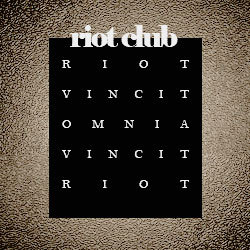
❝ He’s the afternoon in his quiet sublime not quite the sunrise, but not quite when it sets he is somewhere in between him and him, both of which bore his name at one point. at some point.❞
Amir Jain | twenty-four (III) | The Riot Club | Sidharth Malhotra | open

It's relatively easy to get lost in his eyes, the darkest possible pair of irises, but the black holes are soothing and gentle and the light in them shines more strongly through the contrast. Amir has always been a soft child, who wrote poetry on his mother's day and left the garden bare by giving his grandmother a rose every day. Yet, it is a wonder how he could keep his kindness and grow into a gentleman when surrounded by life's finest and temptation at every step. It is just that everything glittery had no value to him and no matter what car he was driving through campus, he would still get out of the car and pick up a dandelion from the sideway. For that, he left to university with the minimum possible trust fund and even took a job as a barista in his first year, although it didn't work out as well as in theory and he had to draw the responsible kid line there. He doesn't mean to be spoiled, but he is, even more than most of these other people acting like they own the world and flaunting their possessions with frivolity. The spoon he has been fed with was of gold, not silver, and no matter how much he likes to think of himself as simple and spiritual as possible and where he parks his car, he is used to a certain lifestyle and doesn't know sorrow. He could say all he wants that he undressed his expensive clothing and now wears a decent watch on his wrist, but the privilege soaked in him all the way to the bone. Perhaps a bit too malleable, too easy to bent and influence, and too serious at times, Amir isn't particularly fond of the things the Riot Club stands for, but he couldn't refuse their offer, wanting not only to be nice and make friends rather than enemies rejecting them, but also to belong. And what better way to be part of the university's community than by joining its top circle? His father takes great pride in his son and he encourages his initiative to be a tenth of Oxford's Elite, although he doesn’t understand what the Riot Club truly means. If he did, he would have made Amir withdraw, disappointed that his son — the only child he is giving everything for, whose shoulders were already burdened with the pressure that one day, everything the Jain family ruled and owned would fall on him — shows such rebellious behavior. That describes three fourths of the young man’s life, for he has always been locked in a bubble of duties and expectations that he couldn’t escape and learned to love, having no alternative, until he became something reserved and worn-out. Trying to please everybody and be the best possible version of himself is exhausting and he feels like collapsing to the floor and exploding every day, but it doesn't stop the strict routine. He knows that, if anybody at all can find joggle with everything in their life and come out of it successful, it is him and he has enough ambition to drag himself through the mud and pick himself up gracefully afterwards when he has succeeded. If there is one thing he isn't taking lightheartedly, that is business. He has a mind for it — analytical and strategic despite all the sugars and benignity — and once he hears the words, he can turn from the soft boy next door into an entrepreneur, because he was born into it and his father made sure not to raise a fool. Amir takes the family legacy seriously — as he does with most of the expectations set up for him — having it in his blood to enjoy it, dutiful and down-to-earth. It brings out the competitiveness in him, almost waking up a spark of excitement and ruthlessness in his eyes that the otherwise warm appearance of them would deny in a heartbeat. Despite being good at heart and genuine, seeding no shadow of conflict or frustration if he can help it, Amir has a secret boiling inside his veins, behind closed curtains. It all started last year, after getting remarked for his business passion and the fire in his eyes talking about strategies and approaches. He easily managed to get to the top of the class and lift the eyes of the young, just assigned in her function Ms. Abrams towards him, impressing the professor, but the extents of the impression he has left on her went even further than he had expected. In time, from the teacher's favorite, hanging out even after class to engage in endless conversations and even debates where their opinions didn't meet, Amir grew familiar with the woman and one thing led to another, ending up with their lips meeting. Ever since, it has been all about hotel cards and secondary phones for grades he already deserves and a more mature kind of company. The young man is aware of how easy their daliance can come tumbling down, dragging them with it in ruins, but for once, he has something exciting to live for and although he can't explain the source of his smile to anybody, living on the edge seems to be more interesting than expected to him.

Elizabeth Pemberly Amir only briefly encountered with Elizabeth, but it was enough to leave him with a bitter taste in his mouth the day he heard about her death. Since she had a way of crawling under one’s skin and make most love her in an instant, as if it were magic, the man was no exception to it. He wasn’t in love with Elizabeth — nor could he have been, especially since they barely knew each other — but everybody was a little in love with her, in the end, and he felt like she was too innocent and too childish to take care of herself, and felt instinctively responsible for her well-being. After having taken her under his wing, even for a short amount of time, it is only natural that her death unsettled him. He has made it his life purpose to find out who gave her — such a fragile, defenseless little bird — the drugs that supposedly have ended her life and make them pay. Aria Bellefonte To Aria, Amir is incredibly boring the way he is now. They officially met when she was in a vulnerable place with herself, and he acted like the perfect gentleman that he is, comforted her without crossing any lines and it should have been enough for the girl to be swept off her feet, even if it was unintentional. Yet, Aria found him nothing but a younger, better looking reminder of her grandfather and she decided to put her mind into corrupting him, thinking that he could use her help to loosen up and live a little before he went old physically too. Amir doesn’t mind her perception of him and passively allows her to drag him with her in clubs from time to time, but knows that he won’t change for the worse. What neither knows is that more than a coincidence ties them together and that they have more in common than initially thought. Jacob de Terreros They are roommates, despite Amir affording otherwise, because he is trying to approach a modest lifestyle. Howsoever, they couldn't get along less well, no matter how much both tried to make a connection and turn living together into something pleasant and cordial. It is embarrassing that they can't manage to find a common ground to start on, in spite of sharing the place they live in, but, if anybody at all asks about their dynamic, instantly assuming that they would be the best of friends just because one acts like a prince and the other is literally one, they are answered with the same lie that they are. Pretending a friendship is beneath both of them and an unnecessary lie, but as soon as they took down that route, they couldn't turn back and admit they don't know anything about each other past the color of their toothbrushes. Dexter Carraway Although they have been invited to join the Riot Club at about the same time, they didn't have much of a friendship back in the days, that changing drastically after Dexter's accident, that caused the other man to perceive him as a charity case — his ultimate weakness. Ever since, Amir has been trying to befriend him, because he felt bad about his condition and wanted to help as much as possible, drawn to the tragedy and wanting to flaunt his compassion, although not realizing. Dexter, of course, didn't fight back, always in need for friends and reaching the impressive number of two once Amir decided to get to know him better. Of course that the computer nerd has nothing of the royal grace that is the main vibe Amir gives people, but, regardless, the two get along and share opinions on most things, with few exceptions that the latter chooses to overlook.
1 note
·
View note